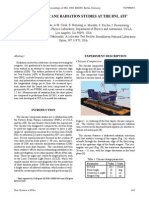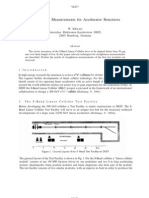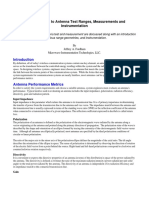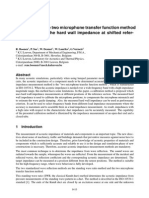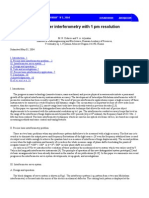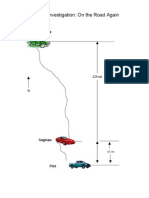Phased Array
Phased Array
Uploaded by
Hüseyin HızlıCopyright:
Available Formats
Phased Array
Phased Array
Uploaded by
Hüseyin HızlıCopyright
Available Formats
Share this document
Did you find this document useful?
Is this content inappropriate?
Copyright:
Available Formats
Phased Array
Phased Array
Uploaded by
Hüseyin HızlıCopyright:
Available Formats
Ultrasonics 38 (2000) 131134 www.elsevier.
nl/locate/ultras
Ultrasonic non-destructive testing of pieces of complex geometry with a exible phased array transducer
Sylvain Chatillon a, *, Gerard Cattiaux a, Marc Serre b, Olivier Roy b
a Institut de Protection et Surete Nucleaire, DES/SAMS, 92265 Fontenay-aux-Roses Cedex, France b Commissariat a lEnergie Atomique, CEREM, CEA-Saclay, Bat. 611, 91191 Gif-sur-Yvette cedex, France `
Abstract Ultrasonic non-destructive testing of components of complex geometry in the nuclear industry faces several diculties: sensitivity variations due to unmatched contact, inaccurate localization of defects due to variations of transducer orientation, and uncovered area of the component. To improve the performances of such testing and defect characterization, we propose a new concept of ultrasonic contact phased array transducer. The phased array transducer has a exible radiating surface able to t the actual surface of the piece to optimize the contact and thus the sensitivity of the test. To control the transmitted eld, and therefore to improve the defect characterization, a delay law optimizing algorithm is developed. To assess the capability of such a transducer, the Champ-Sons model, developed at the French Atomic Energy Commission for predicting eld radiated by arbitrary transducers into pieces, has to be extended to sources directly in contact with pieces of complex geometry. The good behavior of this new type of probe predicted by computations is experimentally validated with a jointed transducer positioned on pieces of various proles. 2000 Elsevier Science B.V. All rights reserved.
Keywords: Complex geometry components; Delay law optimization; Flexible phased array transducer; US eld modeling
1. Introduction The primary and secondary cooling systems of French pressurized water reactors comprise many welding components with complex geometry: elbows, welding with a rough prole, and nozzles. In service inspections of such components performed with conventional ultrasonic ( US) contact transducers present limited performances. First, variations in sensitivity, due to unmatched contact on depressions or irregular surface are observed, resulting in poor detection performances. In addition, the beam orientation transmitted through complex interfaces cannot be totally controlled because of the disorientations suered by the transducer during its displacement, and the detected defect cannot be correctly characterized. Finally, the geometry of certain components such as nozzles disturbs the displacement of the transducer, resulting in an uncovered scan area. To overcome these diculties, a new concept of phased array contact transducer is proposed. Firstly,
* Corresponding author. Tel.: +33-1-69-08-68-07; fax: +33-1-69-08-75-97. E-mail address: sylvain.chatillon@cea.fr (S. Chatillon)
the radiating surface is exible to optimize the contact, and thus the sensitivity, of the testing. Secondly, to improve the characterization of detected defects, the characteristics of the transmitted beam have to be controlled and preserved during the scanning, particularly its actual orientation and focal depth. To this aim, we propose an algorithm that optimizes the delay law. This computation needs the actual position of the elements, so a specic instrumentation is associated with the transducer to measure its radiating surface distortions. In a rst part, the model used to simulate the eld transmitted by a exible phased array contact transducer is presented. Further, a delay law optimizing algorithm is proposed to control the transmitted beam. Finally, experimental results obtained with a jointed contact transducer are proposed to validate its acoustical performances and the optimizing algorithm.
2. Simulation of the US eld The French Atomic Energy Commission (CEA), has developed the Champ-Sons model, which predicts the
0041-624X/00/$ - see front matter 2000 Elsevier Science B.V. All rights reserved. PII: S0 0 4 1 -6 2 4 X ( 9 9 ) 0 0 18 1 - X
132
S. Chatillon et al. / Ultrasonics 38 (2000) 131134
eld transmitted by arbitrary transducers (monolithic and phased array, immersed and wedge coupled) through complex interfaces. This model, implemented in the Civa software, has been experimentally validated for several congurations of immersed inspection [1] and compared to other approximate or exact models [2]. To deal with directly coupled contact transducers, we have to simulate the displacement generated in a solid by an acoustical source applied directly onto its surface. The principle of the selected model [3] is based on the reciprocity theorem [4]. The displacement eld produced by an arbitrary transducer is estimated by numerically integrating this elementary solution on the eective radiating surface. This model, implemented in the Champs-Sons software, makes it possible to simulate the eld transmitted by a exible phased array transducer applied on any arbitrary pieces, taking into account the distortion of its radiating surface.
3. Delay law optimization The focusing process with phased array is usually as follows: the geometrical delay law is computed to ensure constructive interferences at the geometrical focusing point dened by the depth and deection angle. However, signicant dierences between acoustical focusing characteristics, measured on the transmitted beam, and geometrical characteristics are observed. This behavior, well known in the phased array techniques, results from the limited aperture of the transducer [5]. To understand and, further, to take into account these eects, a simplied geometrical model is proposed. The geometrical focusing point is dened by the focal depth, P, and the deection angle, a. For a contact transducer radiating in an homogeneous media, the associated delay law is a spherical cupola centered on the focal point (Fig. 1). The angular aperture observed from the focal point is dened by the rays coming from the transducer edges. In a rst approximation, it can be considered that the beam is focused along the bisector
of this aperture. Due to the deection angle, this axis is dierent from that coming from the center of the transducer. Its orientation, denoted b, is always lower than the deection angle, a. According to this geometrical observation, a model is proposed to quickly predict the acoustic focal characteristics of the beam transmitted by a contact phased array transducer. It entails dening an equivalent monolithic transducer, taking into account the applied delay law: its radiating prole in the incidence plane is a semicircle, centered on the focal point, extending in the angular aperture. The beam orientation is given by that of the symmetry-axis of the equivalent transducer. The focal position is estimated by computing the amplitude distribution of the eld transmitted along this axis. The performances of this model are estimated for a 4820 mm linear phased array transducer generating 2.0 MHz transient waves. Fig. 2 compares the computed and expected (reference) focal characteristics for a 50 mm focal depth and ve deection angles, 0, 15, 30, 45 and 60. The results given by this model show very good agreements with the focal characteristics obtained by Champ-Sons. This model is used in an iterative process to optimize the delay law to control the beam orientation. The method involves searching the focusing point, at the depth of interest, so that the bisector of the angular aperture has the desired orientation. The result is an increase in deection angle. This algorithm is fast enough to be used in a real-time process.
Fig. 1. Geometrical modeling of the focusing process.
Fig. 2. Acoustic focal characteristics estimated by the geometrical model and Champ-Sons.
S. Chatillon et al. / Ultrasonics 38 (2000) 131134
133
4. Results These experiments are performed using the F.A.U.S.T. ( Focusing Adaptive UltraSonic Tomography) system [68]. The exible transducer is composed of 24 rigid elementary ultrasonic transducers (elements), mechanically assembled with cables and helical springs. The design of each elements ensures distortions of the radiating surface with a 15 mm local curvature radius (see Fig. 3). The transmitted eld is measured using a wide-band contact probe receiver with a central frequency of 2.25 MHz. 4.1. Measurements in a static mode The prole of the steel block consists of three parts: a concave part and a convex part with a 50 mm radius curvature and a concave/convex part with a 25 mm radius curvature. On the opposite face, four steps, respectively located at 20, 30, 40 and 50 mm from the reference plane, allow measurements of the transmitted eld. For each step, the eld resulting from geometrical and optimized delay laws is measured for three deection angles (0, 45 and 60). The measurements obtained through the complex interfaces are compared to those obtained through the plane interface in order to estimate how the eects caused by the distortion of the radiating surface on the transmitted beam are dealt with. Examples are shown in Figs. 4 and 5 for a 40 mm depth focusing with a 45 deection angle for the most unfavorable case: the concave/convex interface. The grating lobe level and the focal width are reported on the echodynamic. First, a good agreement between experimental and simulated results is observed. In all the studied congurations (prole, depth, deection angle), the characteristics of the focal area (position, orientation, width, amplitude) are well predicted. Further, compared to a plane interface, the distortions of the
Fig. 4. Field transmitted at 40 mm through a plane interface for a 40 mm/45 focusing.
Fig. 5. Field transmitted through a concave/convex interface for a 40 mm/45 focusing.
transmitted focal beam remain acceptable although signicant distortions are suered by the radiating surface. The maximal increase of the focal width is 40%, the maximal loss in sensitivity is 3 dB, and the maximal increase of the grating lobe level is 3 dB. In all cases, the actual focal beam orientation is well predicted by the simplied geometrical model. The average discrepancy is less than 2. 4.2. Measurements in a dynamic mode In order to assess the acoustic capabilities of the jointed transducer during the scanning of an irregular surface, the transmitted eld is measured for ve positions of the transducer on a test piece with a 20 mm local curvature radius surface depression. For each position, separated by 10.0 mm, we measure the focal width, the focal amplitude, the beam orientation and the grating lobe level. Two depths, 30 and 50 mm, and two orientations, 45 and 60 , are studied. Fig. 6 repre-
Fig. 3. Distortion of the jointed transducer with a 15 mm local curvature radius.
134
S. Chatillon et al. / Ultrasonics 38 (2000) 131134
the geometrical aberrations and transmit a focal beam with controlled and homogeneous characteristics.
5. Conclusion We propose a new concept of phased array contact transducer designed to optimize the inspection of complex geometry components. Its radiating surface is exible to optimize the contact along degraded or complex proles. An algorithm is proposed to determine, in a fast way, the delay law ensuring the control of the transmitted focused beam characteristics. Experimental results obtained in transmission with a jointed transducer validate the good behavior predicted by simulated data. The use of the delay law optimizing algorithm ensures the transmission of an homogeneous and controlled beam during the transducer displacement along complex geometry. Experiments in pulse-echo mode are in progress to estimate the defect detection and characterization performances of this method.
Fig. 6. Fields transmitted at 30 mm for a 30 mm/45 focusing in ve dierent positions.
References
[1] M. El Amrani, P. Calmon, O. Roy, D. Royer, O. Casula, in: D.O. Thompson, D.E. Chimenti ( Eds.), Rev. of Prog. in QNDE Vol. 14A (1995) 1075. [2] P. Calmon, A. Lhemery, J. Nadal, in: D.O. Thompson, D.E. Chimenti (Eds.), Rev. of Prog. in QNDE Vol. 15A (1996) 1019. [3] A. Lhemery, R. Stacey, in: D.O. Thompson, D.E. Chimenti ( Eds.), Rev. of Prog. in QNDE Vol. 14 (1995) 997. [4] K. Aki, P.G. Richard, 1980. [5] M. El Amrani, Etude de dierentes methodes de focalisation ultra sonore appliquees au controle non destructif, Ph.D. thesis, Uni versite Paris 7, 1996. [6 ] S. Mahaut, G. Cattiaux, O. Roy, P.H. Benoist, Proc. 14th Int. Conf. NDE in the Nuclear and Pressure Vessel Ind, 1996. [7] S. Mahaut, G. Cattiaux, O. Roy, P.H. Benoist, in: D.O. Thompson, D.E. Chimenti (Eds.), Rev. of Prog. in QNDE Vol. 16B (1997) 2085. [8] O. Roy, S. Mahaut, M. Serre, in: D.O. Thompson, D.E. Chimenti ( Eds.), Rev. of Prog. in QNDE Vol. 17, (1998).
sents the elds transmitted at 30 mm for a 30 mm depth focusing at 45. The focal beam amplitude is referred to that obtained through the plane interface. At each position, the characteristics of the focal beam transmitted are very close to those obtained through the plane interface. The orientation of the transmitted beam is nearly constant along the transducer displacement (the maximal variations are less than 2). The variations in sensitivity are less than 2 dB, the focal width is nearly constant (even narrower at the position situated 10 mm before the depression center) and no signicant increase in grating lobe level is observed ( less than 2 dB). These results show the ability of the jointed transducer associated with the delay law optimization algorithm to correct
You might also like
- Lab Report!!!Document10 pagesLab Report!!!Dharshanaa Babu0% (1)
- En 13018Document10 pagesEn 13018Hüseyin HızlıNo ratings yet
- Composite Materials Handbook Mil-Hdbk-17-5 Volume 5Document260 pagesComposite Materials Handbook Mil-Hdbk-17-5 Volume 5javier_gonzalez_cid8060No ratings yet
- Recent Developments in Ultrasonic NDT Modelling in CIVADocument7 pagesRecent Developments in Ultrasonic NDT Modelling in CIVAcal2_uniNo ratings yet
- Application of Tandem Techniques With Contact Mono-Elements or Phased Array Probes: Simulation and ExperimentsDocument10 pagesApplication of Tandem Techniques With Contact Mono-Elements or Phased Array Probes: Simulation and ExperimentsAbd Rahman AliasNo ratings yet
- Technical Note - Development and Research of - Khmelev, Sergei S - Khmelev, Vladimir N - Golykh, Roman NDocument7 pagesTechnical Note - Development and Research of - Khmelev, Sergei S - Khmelev, Vladimir N - Golykh, Roman Nandrea assanelliNo ratings yet
- Sensors 13 02093Document20 pagesSensors 13 02093r39174746No ratings yet
- Numerical Simulation of Sonic Boom Near-Field FlowDocument6 pagesNumerical Simulation of Sonic Boom Near-Field Flownbt1234No ratings yet
- FEM Acoustic Analysis - NDT Angle Beam ExampleDocument28 pagesFEM Acoustic Analysis - NDT Angle Beam ExampleN DNo ratings yet
- Calculations of The Dispersive Characteristics of Microstrips by The Time-Domain Finite Difference MethodDocument5 pagesCalculations of The Dispersive Characteristics of Microstrips by The Time-Domain Finite Difference MethodSudantha Jayalal PereraNo ratings yet
- Ref62 Bailin - Hughes.1952Document7 pagesRef62 Bailin - Hughes.1952aveliveloNo ratings yet
- Magnetic Chicane Radiation Studies at The BNL Atf: Experiment DescriptionDocument4 pagesMagnetic Chicane Radiation Studies at The BNL Atf: Experiment DescriptionParticle Beam Physics LabNo ratings yet
- KunduDocument10 pagesKunduAshwary Sheel Wali Research Scholar, Dept of Mech Engg., IIT (BHU)No ratings yet
- Multifocal AntennaDocument5 pagesMultifocal AntennaLazni NalogNo ratings yet
- A Scintillator Based Halo-Detector For Beam Position MonitoringDocument3 pagesA Scintillator Based Halo-Detector For Beam Position MonitoringSean Captain HonestlagoNo ratings yet
- Finite Element Numerical Simulation Analysis BasedDocument8 pagesFinite Element Numerical Simulation Analysis BasedBenjoy JohnNo ratings yet
- Pipe Elbow Inspection With Guided WavesDocument6 pagesPipe Elbow Inspection With Guided WavesCarlos BustamanteNo ratings yet
- Lep4506 00Document5 pagesLep4506 00Khan YousafzaiNo ratings yet
- Teyssieux Proceeding Ieeeuffc v3Document4 pagesTeyssieux Proceeding Ieeeuffc v3Evilásio SouzaNo ratings yet
- A CMOS Front-End Hall Sensor Microsystem For Linear Magnetic Field Measurement With Best Tradeoff Between Sensitivity ADocument8 pagesA CMOS Front-End Hall Sensor Microsystem For Linear Magnetic Field Measurement With Best Tradeoff Between Sensitivity AMitchell LeeNo ratings yet
- High-Density Integrated OpticsDocument11 pagesHigh-Density Integrated OpticsRomil ShahNo ratings yet
- MFL Compendium 002Document59 pagesMFL Compendium 002kingston67% (3)
- CVI Optical SpecificationsDocument8 pagesCVI Optical SpecificationsAmir MolazecirovicNo ratings yet
- Journal of Kones 2014 No. 1 Vol. 21 Issn 1231-4005 BarskiDocument8 pagesJournal of Kones 2014 No. 1 Vol. 21 Issn 1231-4005 BarskiKaleeswaran EinsteinNo ratings yet
- Vftos in GISDocument5 pagesVftos in GISdeepak_27No ratings yet
- Statkiewicz2005 PDFDocument9 pagesStatkiewicz2005 PDFSebastian Soto PerdomoNo ratings yet
- 2007 - XXX ENFC 2007 - Low Cost Reflective Fiber-Optic Sensor Applied To Resonance Frequencies Measurement of Flextensional Piezoelectric ActuatorsDocument4 pages2007 - XXX ENFC 2007 - Low Cost Reflective Fiber-Optic Sensor Applied To Resonance Frequencies Measurement of Flextensional Piezoelectric ActuatorsClaudioCaetanoNo ratings yet
- Decaying DC Offset Removal Operator Using Mathematical Morphology For Phasor MeasurementDocument6 pagesDecaying DC Offset Removal Operator Using Mathematical Morphology For Phasor Measurementsirisiri100No ratings yet
- Simulation of Ultrasonic Guided Wave Inspection in CIVA Software PlatformDocument10 pagesSimulation of Ultrasonic Guided Wave Inspection in CIVA Software PlatformMohsin IamNo ratings yet
- Differentiating Walls From Corners Using The Amplitude of Ultrasonic EchoesDocument13 pagesDifferentiating Walls From Corners Using The Amplitude of Ultrasonic EchoesQassem MohaidatNo ratings yet
- Application of Ultrasonic Guided Wave To Heat Exchanger Tubes InspectionDocument6 pagesApplication of Ultrasonic Guided Wave To Heat Exchanger Tubes InspectionAqib Ali100% (1)
- MFL Compendium - 001Document26 pagesMFL Compendium - 001kingston100% (2)
- Detection of Defects in A Thin Steel Plate Using Ultrasonic Guided WaveDocument8 pagesDetection of Defects in A Thin Steel Plate Using Ultrasonic Guided WaveCarlos BustamanteNo ratings yet
- Straightness Measurements For Accelerator StructuresDocument14 pagesStraightness Measurements For Accelerator Structureselson_paulNo ratings yet
- Artzner 1998Document15 pagesArtzner 1998Mitadru BiswasNo ratings yet
- Multipath Cross-Correlation Flowmeters: V. Skwarek and V. HansDocument6 pagesMultipath Cross-Correlation Flowmeters: V. Skwarek and V. HansriannataNo ratings yet
- Progress in Electromagnetics Research, Vol. 113, 103-110, 2011Document8 pagesProgress in Electromagnetics Research, Vol. 113, 103-110, 2011Rasheduzzaman SifatNo ratings yet
- 1998 - Ultrasonic C-Scan Standardization For Polymer-Matrix CompositesDocument8 pages1998 - Ultrasonic C-Scan Standardization For Polymer-Matrix Compositesdhiraj.biswasNo ratings yet
- Introduction To Antenna Test Ranges Measurements InstrumentationDocument13 pagesIntroduction To Antenna Test Ranges Measurements Instrumentationgnanalakshmi100% (1)
- SaborDocument8 pagesSaborTushar SarkarNo ratings yet
- GWT 2Document7 pagesGWT 2Asish desaiNo ratings yet
- Calibration of The Two Microphone Transfer Function Method by Determining The Hard Wall Impedance at Shifted Reference Sections.Document12 pagesCalibration of The Two Microphone Transfer Function Method by Determining The Hard Wall Impedance at Shifted Reference Sections.DivyasreeUddandapuNo ratings yet
- Multi-Band Patch Antenna Tuning by A Fractal-Shaped Erosion ProcessDocument4 pagesMulti-Band Patch Antenna Tuning by A Fractal-Shaped Erosion ProcessNag ChallaNo ratings yet
- Broadband Fluxgate MagnetometerDocument8 pagesBroadband Fluxgate MagnetometerJose Roberto0% (1)
- Interferometric SeismometerDocument6 pagesInterferometric SeismometerVistaNo ratings yet
- Testing Masonry StructuresDocument89 pagesTesting Masonry Structuresmusiomi2005No ratings yet
- Opposite Phased Transducer Opt For Sizing of DefectsDocument12 pagesOpposite Phased Transducer Opt For Sizing of DefectsprabuNo ratings yet
- Analysis of Acoustic Characteristics According To Design Parameter of DiaphragmDocument5 pagesAnalysis of Acoustic Characteristics According To Design Parameter of Diaphragmrajendra_krishna_1No ratings yet
- A Generalized Diffraction Synthesis Technique For High Performance Reflector AntennasDocument14 pagesA Generalized Diffraction Synthesis Technique For High Performance Reflector AntennasParastoo TaghikhanyNo ratings yet
- Theoretical Modelling of Ultrasonic Non-Destructive TestingDocument5 pagesTheoretical Modelling of Ultrasonic Non-Destructive TestingAmir JoonNo ratings yet
- Distance-Dependent Dual-Cavity Fibre Interferometer For Vibration AnalysisDocument6 pagesDistance-Dependent Dual-Cavity Fibre Interferometer For Vibration AnalysisShina MaliakkalNo ratings yet
- Properties of An Ultra-Short Gain Length, Saturated, Self-Amplified Spontaneous Emission FELDocument20 pagesProperties of An Ultra-Short Gain Length, Saturated, Self-Amplified Spontaneous Emission FELParticle Beam Physics LabNo ratings yet
- ErrorsDocument4 pagesErrorsBenson Mwathi MungaiNo ratings yet
- Guided Wave TransmissionDocument8 pagesGuided Wave Transmissionprem aleNo ratings yet
- Atmospheric Aberrations in Coherent Laser Systems: Snowmass, July 12, 2007 Aniceto BelmonteDocument40 pagesAtmospheric Aberrations in Coherent Laser Systems: Snowmass, July 12, 2007 Aniceto BelmonteImad Ha AliNo ratings yet
- Phase-Shift Fizeau Interferometer in Presence of VibrationDocument12 pagesPhase-Shift Fizeau Interferometer in Presence of VibrationMircea BujorNo ratings yet
- PIIS1120179712000658Document9 pagesPIIS1120179712000658johan NGONTIENo ratings yet
- Huissoon 1991Document12 pagesHuissoon 1991Luis CastellanosNo ratings yet
- Modeling of Vibration Sensing With Variable Fabry-Perot SystemDocument6 pagesModeling of Vibration Sensing With Variable Fabry-Perot SystemfadhaliNo ratings yet
- Surface Accuracy Analysis of Single Panels For The Shanghai 65-M Radio TelescopeDocument8 pagesSurface Accuracy Analysis of Single Panels For The Shanghai 65-M Radio TelescopeManoj KumarNo ratings yet
- Electromagnetic Time Reversal: Application to EMC and Power SystemsFrom EverandElectromagnetic Time Reversal: Application to EMC and Power SystemsFarhad RachidiNo ratings yet
- Barkhausen Noise InspectionDocument3 pagesBarkhausen Noise InspectionHüseyin HızlıNo ratings yet
- Comparison Between Airbus A380 & Boeing 787 DreamlinerDocument11 pagesComparison Between Airbus A380 & Boeing 787 DreamlinerHüseyin HızlıNo ratings yet
- CIE PhysicsDocument14 pagesCIE PhysicsengrroyNo ratings yet
- Hays 1976Document12 pagesHays 1976Gabriel Andres Rodriguez ZuluagaNo ratings yet
- Mixing in Bubble Column and Airlift ReactorsDocument8 pagesMixing in Bubble Column and Airlift ReactorsOki SetiawanNo ratings yet
- One-Man RF Power Flux Basic Measurements With A Spectrum Analyzer Rohde&SchwarzDocument16 pagesOne-Man RF Power Flux Basic Measurements With A Spectrum Analyzer Rohde&SchwarzJohn Bofarull GuixNo ratings yet
- Height and DistanceDocument7 pagesHeight and Distancenganeshn1988No ratings yet
- 2004 LEE, S., STEVENSON, S. Real State Portfolio Construction and Estimation RiskDocument20 pages2004 LEE, S., STEVENSON, S. Real State Portfolio Construction and Estimation RiskMelquiades PereiraNo ratings yet
- OSM ConsolEx 4B11 11a lv2 E-1Document3 pagesOSM ConsolEx 4B11 11a lv2 E-1mikeeeerrNo ratings yet
- A Model To Determine Atmospheric Stability and Its Correlation With CO ConcentrationDocument6 pagesA Model To Determine Atmospheric Stability and Its Correlation With CO ConcentrationSaurabh GargNo ratings yet
- Motion and Time Class 7 Extra Questions Science Chapter 13 - Learn CBSEDocument1 pageMotion and Time Class 7 Extra Questions Science Chapter 13 - Learn CBSEHarveen KaurNo ratings yet
- 3.1.3 Processes and Mapping (1/5)Document74 pages3.1.3 Processes and Mapping (1/5)Mohamadi YNo ratings yet
- Extra Problems Kirchhoff Solutions PDFDocument4 pagesExtra Problems Kirchhoff Solutions PDFArnoldZulu100% (1)
- User Guide Gpec 2012 1Document27 pagesUser Guide Gpec 2012 1João GuilhermeNo ratings yet
- Investigation: On The Road AgainDocument4 pagesInvestigation: On The Road Againapi-20133258No ratings yet
- Fitting: Pressure Loss From Fittings - 2K MethodDocument10 pagesFitting: Pressure Loss From Fittings - 2K MethodNoor AiniNo ratings yet
- Transportation and SCM PDFDocument98 pagesTransportation and SCM PDFAmer ButtNo ratings yet
- Game Theory: Parts I and II - With 88 Solved Exercises. An Open Access TextbookDocument242 pagesGame Theory: Parts I and II - With 88 Solved Exercises. An Open Access TextbookKarl JockerNo ratings yet
- VM 02 Spread FootingDocument10 pagesVM 02 Spread FootingxccvcvNo ratings yet
- Year US National Debt ($1,000,000,000)Document7 pagesYear US National Debt ($1,000,000,000)Belle SharrarNo ratings yet
- My Best Puzzles in Mathematics - Hubert PhillipsDocument116 pagesMy Best Puzzles in Mathematics - Hubert Phillipssheetalparshad100% (1)
- Gear Tooth Strength Analysis: 2006 by W.H.DornfeldDocument14 pagesGear Tooth Strength Analysis: 2006 by W.H.DornfeldlitonNo ratings yet
- TorsionDocument2 pagesTorsionMyra BorrerosNo ratings yet
- GEM4D Comparing Hydraulic Radius and Radius FactorDocument5 pagesGEM4D Comparing Hydraulic Radius and Radius Factorarmel simpore100% (1)
- Maths Guidance Year 5Document80 pagesMaths Guidance Year 5ShaminaNo ratings yet
- Numerical Methods: MATH-351Document14 pagesNumerical Methods: MATH-351Anelya YerkinbekNo ratings yet
- Signed Learning Material No. 3 Problem Solving and Reasoning TemplateDocument11 pagesSigned Learning Material No. 3 Problem Solving and Reasoning TemplateAira Mae Quinones OrendainNo ratings yet
- Electrostatics Objective BitsDocument3 pagesElectrostatics Objective Bitsganesh4u_p100% (1)
- CS Foundation Solved Scanner Paper-2BDocument15 pagesCS Foundation Solved Scanner Paper-2BBrijesh Kapuriya67% (3)
- Spgp390 (Low Frequency Model)Document7 pagesSpgp390 (Low Frequency Model)danjohhnNo ratings yet
- Marcel Chelba - The Consolation of Philosophy? (Comment On An Article by Lawrence M. Krauss: The Consolation of Philosophy)Document6 pagesMarcel Chelba - The Consolation of Philosophy? (Comment On An Article by Lawrence M. Krauss: The Consolation of Philosophy)marcel chelbaNo ratings yet
- CH 5 Earthwork and QuantificationDocument43 pagesCH 5 Earthwork and QuantificationZeleke Taimu0% (1)











